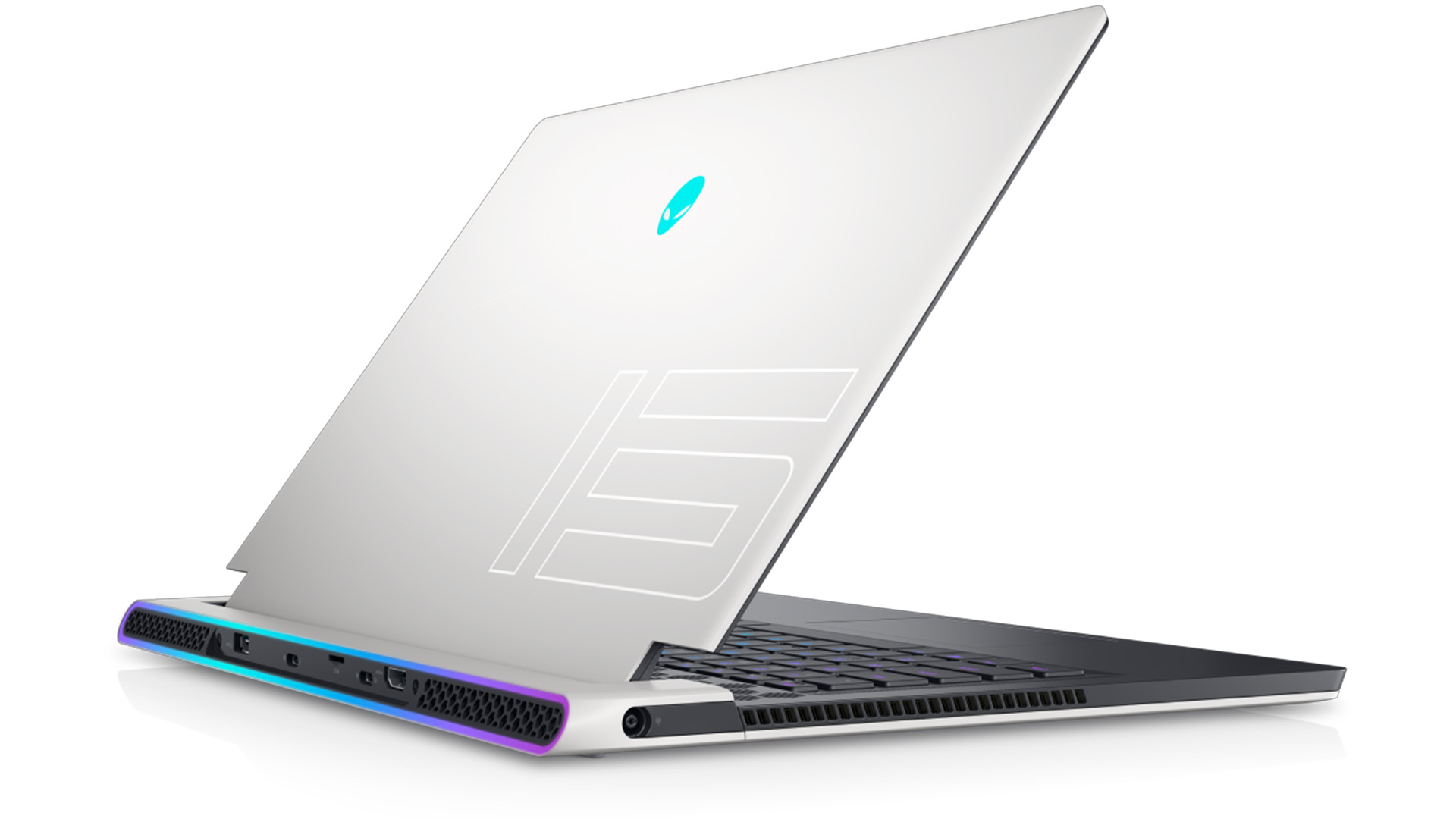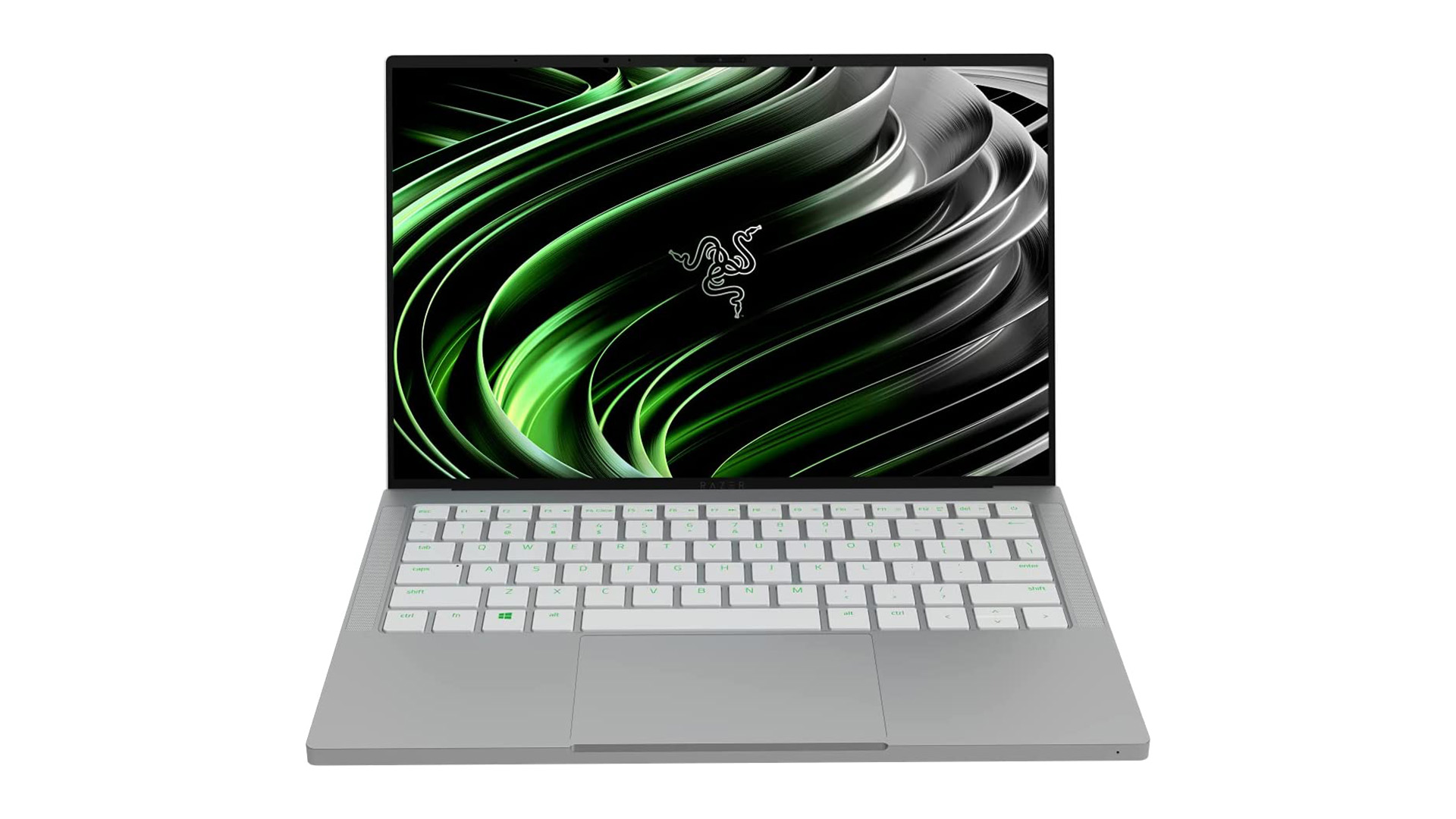
Display size: 15.6-inch
Display: 1920x1080 resolution, 165Hz refresh rate
Capacity: 512GB, 1TB, 2TB, 4TB, 8TB M.2 drive
Chip: 12th Gen Intel® Core™ i7-12700H
Camera: 720p webcam
Speakers: 4 stereo speakers
Weight: 5 lbs
The Alienware x15 isn't cheap – the model we’re using for comparison here will cost you $2,249.99 – but it does offer a slimline, distinctive design with a large display and plenty of grunt.
The NVIDIA GeForce RTX 3060 inside is the cheaper of the starting options here, but it’s still capable of playing demanding titles on the go, and there are 3070 and 3080 options available too. The 512GB of storage is on a superfast M.2 drive, too.
There are some nitpicks, though – a 720p webcam on a machine at this price is a little disappointing, even if it’s not built for your daily Zoom calls, and the panel has a 1080p resolution (a 1440p option can be added). Thankfully, it does have a high refresh rate of 165Hz for more twitch-based gameplay.
Still, right out of the box, this machine is ready to play the likes of Cyberpunk 2077 or Overwatch 2, and handle any creative work you can throw at it.
For
- Able to play the latest games
- Plenty of ports
- High refresh rate
Against
- 720p webcam is disappointing
- 1080p resolution may not be enough for some

Display size: 13.4-inch display
Display: 3840x2400 resolution, touch display
Capacity: 1TB
Chip: 11th Gen Intel® Core™ i7-1165G7 Quad-Core Processor
Camera: 720p webcam
Speakers: 2 Stereo Speakers
Weight: 3 lbs
The 13.4-inch display size makes the Razer Book impressively portable – and it weighs just 1.4kg. Open it up, though, and the display is gorgeous, with a resolution of 3840x2400.
It’s a screen so good you’ll want to reach out and touch it – and you can, since it’s a touch screen which is ideal for Windows 11 (installed right out of the box).
There’s 1TB of storage onboard, and while the Razer Book is running an 11th Gen Intel Core i7, it’s still plenty fast.
The main disappointment really is its lack of gaming nous. It’s running on Intel’s Iris Xe Graphics, which are power-efficient but aren’t going to offer the performance you’ll find on the Alienware model that’s similarly priced. That means if you want to play games on a Razer machine, you’ll have to cough up considerably more.
There’s also a 720p webcam again, which just feels almost unfair in this day and age.
For
- Gorgeous display
- Touch screen
Against
- Another disappointing 720p webcam
- Lacks dedicated GPU
- Expensive
When it comes to gaming laptops, there are two brands that are certainly jostling for position at the top of the food chain – Razer and Alienware, an offshoot from Dell’s more straight-laced machines.
While both are manufacturers with a wealth of experience in portable computing, it was tough to find a pair of laptops in a similar pricing bracket for the purposes of pitting Alienware vs Razer in this test.
That’s because while no gaming laptop is particularly cheap, the Alienware x15 actually looks like a solid value proposition next to some of Razer’s similarly-specced 15-inch machines. Since value is a huge part of this article, we opted for the similarly priced (£1799.99) Razer Book as our comparison point.
Both are great laptops, but both actually have very different roles here. The Razer Book, for example, offers a touchscreen, while the Alienware packs a much more powerful GPU. With that in mind, picking a winner between the two will likely come down to what you intend to do with either machine (much like our iPad and Chromebook comparison) – but we’ll get to that shortly.
Alienware vs Razer: Design
It’d be fair to say that the Razer Book looks like a pretty standard laptop. It has a nice clean design, with a TKL keyboard and the Razer logo embossed on the lid. It’s not going to win any fashion contests, but it really doesn’t need to – it’s designed to be carried into your office or workplace and not cause too much fuss.
There are hints of Razer’s gaming chops, though, with per-key RGB lighting within the keyboard, and that gorgeous display which we’ll come to shortly.
On the other hand, the Alienware x15 wants to be seen. Its hinge is separated from the rest of the base by cutouts on either side, giving the impression of its screen rising up to meet your gaze. It has vent cut-outs above and to the side of the keys, and its own RGB lighting, while its ports are conveniently tucked behind.
While we’re not big fans of the big “15” on the lid, much of this category comes down to preference. The x15 has style, but if you’re looking for something more low-key, the Razer Book is great.
Winner: Tie
Alienware vs Razer: Display
If you’re looking to do any creative work, a higher resolution is likely to be important to you - and the Alienware x15’s 1080p may not cut it for you.
That’s not to say it’s a bad display by any means, with a 165Hz refresh rate that makes it idea for twitchy shooters.
In terms of the core specs though, we have to plump for the Razer Book in this category. It’s down to 60Hz, sure, and 13.4-inches but unless you’re gaming on it you’ll appreciate a much sharper 3840x2400 resolution and wider viewing angles.
The Razer Book has a touch screen, too. That may not be quite what you’re after, but it doesn’t hurt to have the option anyway.
Winner: Razer Book
Alienware vs Razer: Audio
When it comes to audio, the Alienware x15 has double the speakers of the Razer Book, further cementing its place as a media consumption and gaming device.
Cranking the audio with the keys on the side of the keyboard allows for an impressive range of audio, although we’d be lying if we said it was anywhere near as good as the latest MacBook Pros from Apple.
Apple also doesn’t get a great deal of competition from Razer in this space, either, although we would say the speakers on the Razer mid offer great mids – we’d just have liked more oomph from the bass.
We also found that the fan noise gets pretty loud on the Razer Book, and that means we handed this category to the Alienware x15.
Winner: Alienware x15
Alienware vs Razer: Performance
Despite being a Razer laptop, the Razer Book’s performance is dependable but lacks real power. That’s because it’s using an integrated graphics card, which doesn’t have the guts for running the latest titles.
You may have some solid results in games that don’t rely on quick movement, and it’ll run The Sims 4 just fine, but it’ll struggle to hold a candle to the Alienware x15.
The latter’s 3060 card is by no means an industry leader, but it’ll run the likes of Cyberpunk 2077 at decent settings.
Away from gaming, though, you’ll find very little difference using either for your day-to-day tasks. Whether it’s managing email, streaming music, or editing photos, both are great laptops. For the gaming prowess, though, we’ve given this one to the Alienware.
Winner: Alienware x15
Alienware vs Razer: Value
As we keep coming back to in this article, the Razer Book is a great laptop – but it’s not a “true” representation of what the brand is capable of since Razer’s gaming laptops at the high-end are almost prohibitively expensive.
That makes it look like a relatively pedestrian machine when pitted against Alienware’s x15, but even that could be fitted with a more powerful GPU and more storage at a high cost.
It’s a difficult proposition, but as an all-rounder, we’ve gone for the Alienware.
Winner: Alienware x15
Alienware vs Razer: Verdict
Based on the number of categories alone, this is an easy win for the Alienware x15 – but that doesn’t tell the whole story.
If your budget can stretch to the heights of the Razer gaming lineup, there are formidable options available for just over £2000. It’s a tough sell, though, when the Alienware x15 is such a solid performer at around £300 less.
The Razer Book isn’t a bad laptop by any means, and its display trumps the x15 with ease, but its productivity focus means the two are fighting for two different markets.

